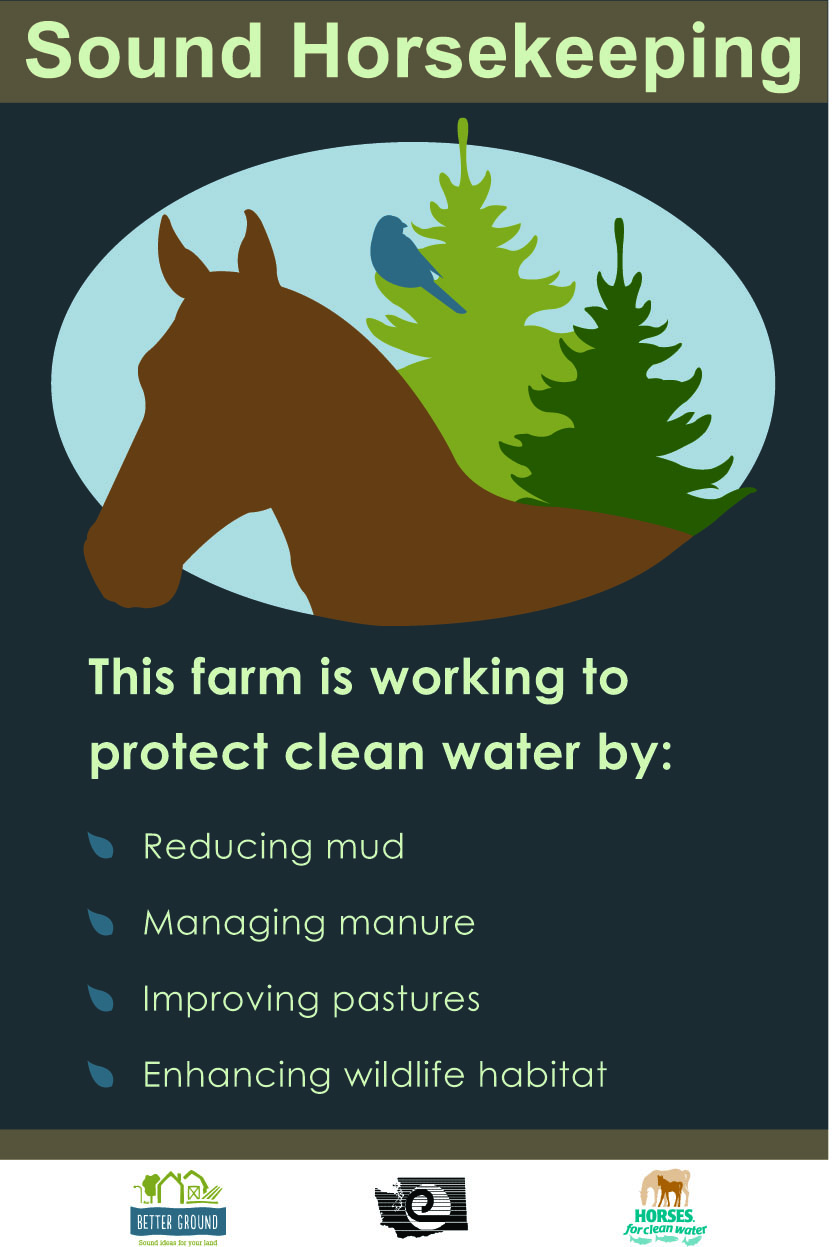Sound Horsekeeping Sign Program
/<<--Back to Sound Horsekeeping Helpful Tips
If you’re managing manure, mud, and pastures in a way that protects horse health and the environment, you’re probably eligible to earn our Sound Horsekeeping sign!* You do not need to be doing everything on this list to qualify, but the “High Priority Practices” are required.
To apply for the sign, please call for a site visit - 425-335-5634 option 5 or email soundhorse@snohomishcd.org.
Reducing Mud
High Priority Practices
- Install gutters and downspouts. (Downspouts should direct roof runoff away from confinement areas.)
- Create a confinement area (winter paddock).
- Add footing (gravel, etc.) in paddocks.
- Fence off any creeks, wetlands or water bodies.
Additional / Optional Best Management Practices
- Reroute water from roofs, driveways, parking areas and hillsides away from confinement areas. (Install French drains, grassy swales, dry wells, water diversion bars or culverts.)
- Create a mud-free exercise area (e.g., track paddock, trail course, dry-lot turnouts, outdoor arena or round pen).
- Install a rain garden.
- Create vegetative buffer strips on the downslope side of confinement areas, compost bins or other heavy use areas.
Managing Manure
High Priority Practices
- Cover manure pile with a tarp or roof.
- Pick up manure in stalls and confinement areas daily or at least every 3 days.
- Implement a manure disposal plan (advertise for pickup, take somewhere for disposal or have it picked up), or create a spreading calendar.
- Build a manure composting bin(s)/storage area.
Additional / Optional Best Management Practices
- Reduce bedding to minimum required.
Improving Pastures
High Priority Practices
- Keep horses off pastures during the winter months.
- Remove horses from pastures when grass has been grazed down to three inches. Allow grass to re-grow to six to eight inches before grazing again.
Additional / Optional Best Management Practices
- Lime pastures.
- Spread manure or compost on pastures during the growing season (April through October) no more than ½” layer at a time and 3-4” per season.
- Harrow and mow pastures.
- Test your soil.
- Check pastures for weeds and either hand pull, use a weed burner or apply the recommended herbicide in amounts at the recommended time of the year and plant’s lifecycle.
Protecting Wells & Septic Systems
High Priority Practices
- Keep horses off of septic system drain field.
- Pump and inspect septic system regularly.
- Keep horses, livestock and manure storage areas at least 100 feet from a wellhead.
- Test your well water.
Enhancing Wildlife Habitat
- Install bird and/or bat boxes to help control flies and mosquitoes.
- Plant a hedgerow of native plants along driveway, paddocks, pastures or other areas.
- Use other eco-friendly pest control methods such as mosquito dunks or goldfish in troughs for mosquito control, and fly predators for fly control.
- Leave snags, dead or dying trees left in place to provide habitat for wildlife.
- Create brush piles and rock piles for small wildlife.
Questions?
Snohomish Conservation District farm planners can be reached at 425-335-5634 option 5 or email soundhorse@snohomishcd.org.
Depending on where your property is located, Snohomish Conservation District may be able to help you cover the cost for compost bins, graveled confinement areas, gutters, downspouts and underground outlets.
*Please note: You must live within Snohomish County or on Camano Island to qualify. You must also be compliant with local regulations.


